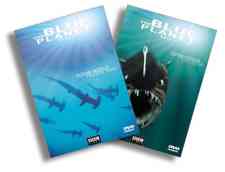|
|


TechnoFILE is copyright and a registered trademark © ® of
Pandemonium Productions.
All rights reserved.
E-mail us Here!

The Blue Planet: Seas of Life CollectionThe Blue Planet: Seas of Life is a series of BBC documentaries exploring various parts of the oceans. Not only are they very entertaining, they’re also (gasp!) educational. By means of underwater cameras, and cameramen crazy enough to get in the middle of breeding and feeding “grounds,” we get a close-up view of some spectacular deep sea events. Narrated by David Attenborough, the first in the series takes us into the “Ocean World” and “Frozen Seas.” The former starts off with some excellent footage of the infamous blue whale, an ocean creature that very few have ever had the pleasure of seeing. It then goes on and explores many other ocean creatures, educating us on their behaviors, eating habits, reproduction, and just about everything else you could possibly want to know. It even shows us exactly why killer whales are called killer whales. You always thought they were pretty friendly, didn’t you? Frozen Seas takes us up north, exploring the lives of polar bears, penguins, seals, and various types of underwater arctic creatures. It’s very in-depth, and is probably even more educational than you’d like to admit. This is probably the better of the two docs on this disc, if only because the animals are doing more than in Ocean World. Pop in disc two and you’ll be taken into the “Open Ocean” and “The Deep.” Open Ocean takes place in the middle of the Pacific Ocean, and has some great footage of tuna, sharks, and other fish feeding. There are a lot of really groovy fish out there, most of them predators. This doc is probably the most well shot, because it actually takes you right into the middle of the action instead of just watching from the sidelines. The Deep is exactly how it sounds. Easily the most fascinating of all the documentaries, it is shot deep under the surface where it’s pitch black. Down there are creatures so odd they would make the platypus say: “You’re goofy lookin!” There are squids and jellyfish that are completely transparent, small, bioluminescent fish, and predators with teeth so big they can’t even close their mouths. This isn’t the kind of place you’d want to get lost. There’s also a short, eerie shot going over the seven-mile-deep Mariana Trench, and an equally eerie “underwater lake” discovered in the Gulf of Mexico. It may be the most slow-moving and unexciting of the docs, but is by far the most mesmerizing. The third disc features “Seasonal Seas” and “Coral Seas.” Probably the least interesting (but still by all means outstanding), Seasonal Seas centers on the variety of creatures that inhabit certain parts of the ocean at certain times of the year. Coral Seas gives us a close-up look at the creatures that live on or in coral reefs around the world. You’d be surprised just how much life there is there. There’s something about a group of shrimp carrying off a starfish that’s oddly amusing. Finally, the last two documentaries are about “Tidal Seas” and “Coasts.” The former examines how life in the sea is affected by the gravity of the sun and the moon. It shows us the effects of, not just daily tides, but also monthly and yearly. It features some of the best individual shots of any of the docs, particularly the stingray breeding ground near New Zealand. It’s just eerie. Coasts has the least amount of actual underwater footage, as the name would imply. We learn about the various birds, fish, and mammals the live on or near the coasts of the world. We learn about two of the ugliest animals to grace the planet: walruses and elephant seals. And, combined with Ocean World, you probably won’t like killer whales after watching this one. They’re vicious buggers, and seem to be the insane members of the sea. Each doc runs about 50 minutes, and each disc totals about 135 minutes, including extras. Having these in 1.78:1 anamorphic widescreen (16X9 enhanced) is a real treat. We were expecting a full screen transfer with average picture, and instead got exactly what we snotty DVD reviewers want. The quality of the picture is excellent, especially when you consider that much of the footage is underwater. There’s never a problem seeing the action, and there is very little grain anywhere to be found. The audio is equally good, despite being only 2.0. David Attenborough’s narration keeps things moving along nicely, while the sounds of the water and animals (and sometimes storms) fill the room effectively. Each disc includes behind-the-scenes featurettes on the making of the documentaries. They’re only about ten minutes long apiece, but are still rather informative. Each disc also sports another featurette; three have an interview with a key member of the production team, and the fourth has a feature on man’s impanct on the Earth’s oceans. Equally interesting (and informative) are the fact files and photo galleries present on every disc. If you enjoyed these documentaries on TV, they’re even more enjoyable on DVD. This is as highly recommended as they come. The Blue Planet: Seas of Life, from BBC Video/Warner Bros. Home Entertainment
|
|
|
|
|
| Support TechnoFile via Paypal |
| TechnoFILE's
E-letter We're pleased to offer our FREE private, subscription-based private E-mail service. It's the "no brainer" way to keep informed. Our Privacy Policy |